Posted by Elena del Valle on December 17, 2010
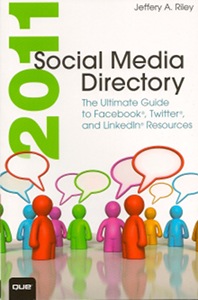
2011 Social Media Directory
Jeffery A. Riley, formerly in the publishing industry, thought it would be helpful to gather a list of companies and organizations with an online presence in the best known social media sites in a book. With that goal in mind he selected what he considers the most important companies and organizations with an online presence on the better known social media sites, Facebook, LinkedIn and Twitter in the 2011 Social Media Directory: The Ultimate Guide to Facebook, Twitter, and LinkedIn Resources (Que Publishing, $19.99). In spite of the title which may give the impression it is a list of social media the book features a list of companies and their social media addresses.
The 296-page softcover book lists 3,000 sources in 15 information categories. Fifteen chapters divided by category list subcategories each one with the name of one or more organizations or companies, a description of each along with the company website and Facebook, Twitter and LinkedIn accounts when available. The main categories are: Business, computers and electronics, current events, politics, education, news, entertainment, health, hobbies, sports, travel, religion, shopping and fashion.
Riley, president, Box Twelve Communications, Inc., a content solutions company, is a former staff writer of the Los Angeles Times. He was involved for 15 years in the information technology publishing industry as copy editor, production editor, development editor, acquisitions editor, executive editor, and author. He is the author of Introduction to OpenOffice.org, and Picture Yourself Learning Microsoft Excel 2010.
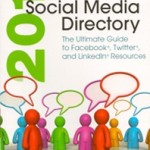
Click to buy 2011 Social Media Directory
Comments:
Filed Under: Books
Posted by Elena del Valle on December 15, 2010

Record, Fútbol al Máximo
Photos: Maya Publishing Group
Economic hardship is affecting many across the United States. Mira, a 10-year old magazine, publishes its last issue this month. Also in the Spanish language print publishing space Maya Publishing Group instituted changes to adjust to market contractions. Last month, Maya began publishing TVnotas, a gossip oriented publication sold in the United States since 1999, twice a month instead of every week.
Starting January 2011 the publisher will convert Récord Semanario de Fútbol, a sports magazine published in the United States since the last quarter of 2008 (see Publisher launches magazine for Spanish speaking Latino soccer fans), from a weekly magazine to a monthly.
Récord Semanario de Fútbol will change its name to Record, Fútbol al Máximo. Plans are in place to add a new section and 32 pages to each issue for a total of 116 pages. The revamped magazine, sold within a bag to allow promotional ad opportunities, will have a change in design slated to include more graphics and less copy.

TVnotas
“We are changing the frequency in two of our titles to optimize our resources, while we are committed with our readers and advertisers to continue delivering excellence in our editorial content, Latin celebrities news and interviews, as well as photographic and top quality printing,” said Alexandra Zanic, marketing manager, Maya Publishing Group, by email.
In addition to TVnotas and Récord Semanario de Fútbol Maya publishes H para Hombres and H para Hombres Extremo, adult magazines for men with a circulation of 50,000 (see Publisher pursues elusive demographic with men’s magazine in Spanish and Florida publisher targets affluent Latino men with adult magazine).
The three Spanish language magazines will be available in the United States in California, Texas, New York, Illinois, New Jersey, Georgia and Florida at airports, newsstands and via retailers including Walgreens, CVS, Publix, HEB, Superior Grocers, and Fiesta Mart. TVnotas is also available in Puerto Rico and online through Zinio.com. Maya Publishing Group, previously Maya Magazines, is the United States arm of Mexico City, Mexico based Notmusa.
Comments:
Filed Under: Media
Posted by Elena del Valle on December 14, 2010
Title: Retail Marketing Specialist
Category: Marketing
Blue Cross and Blue Shield of Florida
City Jacksonville
State FL, 32246
Type: Full Time
Job duties include but not limited to the following:
– Liaison to On-site Retail Center Managers.
– Liaison for all marketing communications requests from the Retail Center Managers. Triage creative and communications work to the Marketing Communications team.
Click here for the full text of Retail Marketing Specialist Blue Cross and Blue Shield of Florida
Posted by Elena del Valle on December 13, 2010
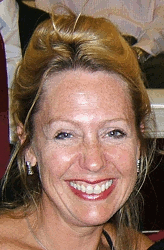
Beth Blatt, CEO, Hope Sings
Photo: Hope Sings
A podcast interview with Beth Blatt, chief executive officer, Hope Sings is available in the Podcast Section of Hispanic Marketing & Public Relations, HispanicMPR.com. During the podcast, Beth discusses microfinance and her company with Elena del Valle, host of the HispanicMPR.com podcast.
Beth has a broad range of creative and corporate experience in the United States, Asia, Europe and Latin America. She is a theater writer, and has also written for television, radio, newspapers and magazines. She produced television for TV Tokyo and worked in account management at Ogilvy & Mather/NY advertising. As an actress, she appeared on stages and screens internationally including the film Godzilla versus Biolante. She is a graduate of Dartmouth College.
To listen to the interview, scroll down until you see “Podcast” on the right hand side, then select “HMPR Beth Blatt,” click on the play button below or download the MP3 file to your iPod or MP3 player to listen on the go, in your car or at home. To download it, click on the arrow of the recording you wish to copy and save it to disk. The podcast will remain listed in the December 2010 section of the podcast archive.
Posted by Elena del Valle on December 10, 2010
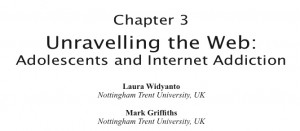
Photos: Mark Griffiths, Ph.D., Joanne Cantor, Ph.D.,
It has become common to see people at a conference presentation while at the same time checking emails or texting on their electronic assistant of choice. Multitasking has become ubiquitous with many people who rely on their technological tools and internet access for work and fun. Many drive, walk, shop, wait in line and so forth while talking or texting. Disconnecting while dining, driving, in the movies, on an airplane or at the grocery store is difficult for some. For many business owners and executives traveling with a laptop or access to the internet, even if the trip is for pleasure, is unthinkable.
Workers spend as much as 40 percent of their time online while at work on non-work related browsing, and make more than half (60 percent) of online purchases during working hours, according to a survey by the International Data Corporation (Snapshot Spy, 2008). As many as 90 per cent of employee respondents to the survey said they felt the internet can be addictive, and 41 percent said they spent more than three hours online per week for personal surfing.
While connectivity and technology provide freedom and enhanced capabilities for millions for some they are the tools or the source of addiction, according to a few expert voices softly surfacing.
Does technological abuse exist? Some believe it does. There are those who distinguish between addictions where addicts use the internet as a means for their addiction and those where the person may be addicted to the internet itself. There is more than one kind of technological or internet abuse according to Mark Griffiths, Ph.D., professor, Nottingham Trent University, in the United Kingdom. In Unraveling the Web: Adolescents and Internet Addiction, a chapter in Adolescent Online Social Communication and Behavior, a book, he and Laura Wydyanto, his co-author of the chapter, address the issue of internet addiction among teenagers.
In a 10-page article, Internet abuse and internet addiction in the workplace, published February 2010 in The Journal of Workplace Learning (Vol. 22 No. 7, 2010 pp. 463-472 qEmeraldGroupPublishingLimited 1366-5626 DOI 10.1108/13665621011071127) he identifies cybersexual internet abuse, online friendship/relationship abuse, internet activity abuse, online information abuse, and criminal internet abuse. He believes internet abuse has the potential to be a serious occupational issue although it has been neglected in research to date.

Conquer CyberOverload book cover
In the United States, Joanne Cantor, Ph.D., addresses the topic in Conquer CyberOverload Get More Done, Boost Your Creativity and Reduce Stress (CyberOutlook Press, $12.95), a 92-page softcover book published earlier this year. In 2008, she began doing research for the book and giving lectures based on her findings. In the spring of 2009, after four months of work she completed the manuscript. She said by email that she has received much positive feedback to the book and related presentations.
“I’m getting very favorable reactions to the book, with most people saying how much it relates to their own lives and how useful the tips are. They also find the brain exercises and the recent research interesting and surprising,” said Cantor by email when asked about the success of her book.
The ReStart Internet Addiction Recovery Program in Washington, in its second year of operation, is touted as the first of its kind. It offers a therapeutic retreat center stay of 45 days or longer for adults suffering from internet and video game addiction, according the the company website. An anonymous ReStart Internet Addiction Recovery Program website survey of 14,000 visitors indicates 10.6 percent of respondents acknowledged having a problem with excessive use of the internet and 39.3 percent of respondents were open to the possibility that they may have a problem. Some 27.2 percent of respondents said they suffer impairments in everyday life and interaction with others because of their internet or video game use.

Joanne Cantor, Ph.D., author, Conquer CyberOverload
As a recovering cyber-addict, Cantor believes it is possible to reach a balance between the benefits of healthy use of connectivity and cyberspace and the needs of leading a productive, creative and well rounded life. In her book, she shares strategies that have helped her overcome her former need to be connected.
The book is dived into an introduction followed by five chapters. She starts out by asking some questions to help the reader determine if he or she may suffer from cyber overload. She goes on to discuss the effects of the digital age; why she believes multitasking may be counterproductive; how too much information can decrease creativity; what she considers are the reasons behind cyber stress; and how readers may be able to control their use of technology.
Cantor, president of Your Mind on Media, is outreach director, Center for Communication Research University of Wisconsin-Madison where she was a professor for 26 years.

Click here to buy Conquer CyberOverload
Comments:
Filed Under: Books
Posted by Elena del Valle on December 8, 2010
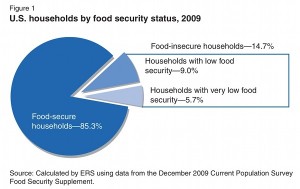
Click to enlarge
Graphic: U.S. Dept. of Agriculture
In 2009, 14.7 percent of residents of the United States or about 50 million people in the Land of Plenty suffered some form of hunger, representing the highest number of households suffering from hunger since 1995 when the first such survey took place. This included 5.7 percent of households where one or more household members ate less and their eating patterns were interrupted sometimes due to lack of money or food. The figures reflect no significant change compared to the previous year although 57 percent of all food-insecure households benefited from a Federal food and nutrition assistance program during the month prior to the 2009 survey.
Another way to look at it that last year only 85 percent of American households had access to enough food for an active, healthy life, according to the Household Security in the United States, 2009, a 62-page report written by Mark Nord Alisha Coleman-Jensen Margaret Andrews Steven Carlson and published by the United States Department of Agriculture (Nord, Mark, Alisha Coleman-Jensen, Margaret Andrews, and Steven Carlson. Household Food Security in the United States, 2009. ERR- 108, U.S. Dept. of Agriculture, Econ. Res. Serv. November 2010)
There were significantly more households with insufficient food than the national average among households with incomes near or below the Federal poverty line, among households with children, headed by single women (36.6 percent) or single men (27.8 percent), Black households (24.9 percent) and Hispanic households (26.9 percent). Households with low food resources were more prevalent than the national average (5.7 percent) for households with children headed by single women (12.9 percent), women living alone (7.4 percent), men living alone (7.1 percent), Black and Hispanic households (both 9.3 percent), households with incomes below 185 percent of the poverty line (14.4 percent), and households located in principal cities of metropolitan areas (6.8 percent).
The states with the highest percent of households with insufficient food were Arkansas (17.7 percent), Texas (17.4 percent) and Mississippi (17.1 percent); the states with the lowest percent of households where occupants went hungry in 2009 were North Dakota (6.7 percent), New Hampshire (just under 9 percent) and Virginia (9.2 percent). Some 17.7 million people (6 percent of Americans) compared with 1.3 million in 2008 had multiple times when they did not have enough food and could not afford meals.
Posted by Elena del Valle on December 7, 2010
Company: Blue Cross Blue Shield of Florida
Job Title: Data Modeler
Job ID #: B1570NOV10
Fulltime
Location: Jacksonville, FL 32246
Job duties include but not limited to the following:
-Develop predictive models which can be used to target consumers for direct marketing campaigns in order to optimize response, conversion, retention or cross-sell initiatives
Click here for the full text of Data Modeler Blue Cross Blue Shield of Florida
Posted by Elena del Valle on December 6, 2010

A scene from the PSA
Photos, video: Adrenalina
Compared to parents of other racial and ethnic groups Hispanic parents are less likely to talk with their children about the risks of drug and alcohol use. About 88 percent of Latino parents talk with their children while 94 percent of African American and 92 percent of Caucasian parents do, according to a 2008 Partnership Attitude Tracking Study. Among the 35 million families in the country with children ages 9-17, nearly 7 million Hispanic families with children in that age group are considered at risk for abusing drugs and alcohol, according to the Partnership at Drugfree.org.
Although in past years the Partnership at Drugfree.org has teamed up with several ad agencies to target Spanish speaking Americans, this year the non profit organization announced an Habla Con Tus Hijos (Talk with your Kids) ad; the first effort designed to build on the nonprofit organization’s Habla Con Tus Hijos initiative, a Spanish-language website and educational campaign aimed at encouraging parents to have frequent conversations with their kids about the risks of drug and alcohol use. Scroll down to watch the video in Spanish.
The series of 15- and 30-second TV and radio spots in Spanish developed by Adrenalina, a New York ad agency with Hispanic market capabilities, showcases a common neighborhood where everyone points to the neighbor’s kid as the source of local drug problems.
“Talking to your kids about drugs isn’t easy for any parent. The message of this campaign is that today it’s imperative,” said Victor Zeiris, creative director, Adrenalina. “This campaign addresses the problem of denial that’s prevalent in our communities. Two key themes of the creative work are to bring this issue to the forefront and to emphasize the importance of prevention.”

A scene from the PSA
El Hijo del Vecino (Spanish for the neighbor’s child) is meant to illustrate that kids are more exposed to drugs than their parents think and to encourage parents to take an active role protecting their children from drugs. The idea is to help them understand that a problem with the neighbor’s kid can easily become their own problem.
In the ads, the characters ignore what organizers believe is the obvious: that drugs in a community are everybody’s problem emphasizing “Asumir que es el problema de otros es el problema” (“Assuming that it’s somebody else’s problem, is the problem.”)
“We expect that this campaign will strike a chord with Hispanic parents who may not grasp that their kids are just as likely to be exposed to drugs as other people’s kids,” said Caryn Pace, deputy director of creative development, the Partnership at Drugfree.org, by email.
The Partnership began airing Spanish language public service announcements in the late 1990’s in print and broadcast. In 2009, the organization launched online resources for the Spanish-speaking community. Although initially there was a greater response with television messages, in 2010 marketers began to see high CTR’s (click-through-rates) for online ads leading to the continuation of its Hispanic digital program.
In 2009, the Partnership launched Habla Con Tus Hijos, its Spanish-language resource for parents and caregivers. The staff plans for 2011 include increasing the scale of content available to Spanish speakers and aligning with Hispanic partners in the public health and media fields to increase the reach of its message and content to target audiences.
“The Partnership at Drugfree.org reaches out to the Latino community in both Spanish and English. We are cognizant that there are many Hispanic parents whose first language is Spanish and therefore prefer to receive their information in that language. Demographically, there are millions of parents who identify as Hispanic/Latino and are fully acculturated, having been born/raised in the U.S., and prefer to receive health information in English,” said Roselena Martinez, marketing/communications manager, the Partnership at Drugfree.org, when asked about the organization’s outreach efforts to Latinos.
“As a result, we communicate with Hispanic parents in both English and Spanish, and our goal with our Spanish messaging is that it be more sensitive to culturally appropriate issues that predominantly Spanish-speaking parents may face, such as lack of understanding of American slang names for drugs, for example. The Spanish-speaking segment of our target audience(s) has responded positively in the past few years as we have created campaigns that are reaching out to Latino parents with cultural sensitivity, responding to real issues that Hispanic parents are facing that are often unique to them, when compared to other demographic groups.”
Eleven members of Adrenalina worked on the ad which was filmed in suburban Los Angeles. The target audience for this initiative is bicultural and less acculturated Spanish-dominant Hispanic parents 37-years-old, on average, with tweens and teens ages 9-14. The TV spots were directed by Simon Bross, with production work provided by Cortez Brothers, Los Angeles, and edited via Bross. Production work for the radio spots was provided by Mixology Lab, New York. All creative work by Adrenalina and its agency partners was produced pro bono. The Partnership at Drugfree.org is a nonprofit organization with a mission to help parents “prevent, intervene in and find treatment for drug and alcohol use by their children.”
Posted by Elena del Valle on December 3, 2010

Iron Butterflies book cover
Photos: Prometheus Books
After spending several years in eight countries and interviewing 50 dynamic women in a variety of careers and jobs Birute Regine, Ed.D., a developmental psychologist, wrote Iron Butterflies: Women Transforming Themselves and the World (Prometheus Books, $19), a book describing the leadership styles and way of thinking of the women she believes are contributing to a social transformation and empowering others.
In the first chapter Regine mentions a Mayan and Mongolian prophecy that foretells the Era of Man ends and the Era of Woman begins this year. She believes the new era will be one of cooperation driven by women’s leadership style that relies on working together for the benefit of a social group. She is convinced that the feminine qualities that for years kept women out of powerful elite circles will drive them to success in the coming years.
Her 299-page softcover book is named for a poem by the same name by Janice Mirikitani. She believes the title reflects the strength, perseverance, resilience, fragility and beauty of the many women she interviewed for the book. In spite of their diverse lives she concluded the women shared five qualities in common. They are vulnerable, revolutionary, healers, strong and welcome paradox.
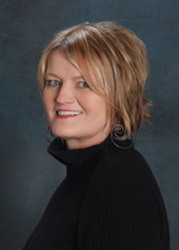
Author Birute Regine, Ed.D.
She interviewed women who dedicate their time to art, poetry, yoga, healthcare, nursing, politics, customer service, choreography, diplomacy, peacemaking, designing clothes, human resources, writing, teaching, consulting, making wine, running a non profit organization, running a football team, and being a spiritual leader.
A resident of Massachusetts and New Hampshire Regine is also an executive coach, speaker and the co-author of Weaving Complexity and Business: Engaging the Soul at Work.

Click here to buy Iron Butterflies
Comments:
Filed Under: Books
Posted by Elena del Valle on December 1, 2010
By Juana M. Véliz
Managing director, Hispanic Practice, Lagrant Communications

Juana M. Véliz, managing director, Hispanic Practice, Lagrant Communications
Photo: Lagrant Communications
New data from the Yankelovich Monitor Multicultural Study 2010 reported what we, as multicultural communicators and marketers, have experienced: Hispanic and African American consumers are more willing to purchase from, and be loyal to, companies actively engaged in their communities to make a positive change.
While one-third of Hispanic and African American consumers said they almost always choose brands because they come from companies that help the causes they support, just one in five non-Hispanic Whites agreed to do the same.
Accordingly, in order to build long-lasting relationships and earn the loyalty of Hispanics/African American consumers, it’s essential to include a social component into our strategies that shows understanding and commitment to their needs.
Click here to read the entire article CSR: A door to social and organizational growth

























